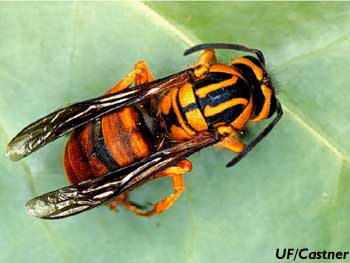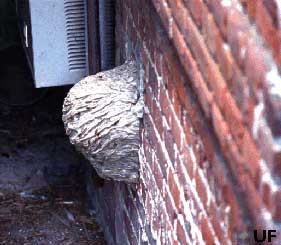
Dr. Philip Koehler
Entomology and Nematology Department
University of Florida
Gainesville, FL 32611-0640

Yellowjackets and hornets are venomous wasps with about 26 species in the United States. The name yellowjacket refers to the typical yellow and black bands on the abdomen although a close relative, the baldfaced hornet, has white and black bands. Yellowjackets do not bite. All yellowjacket species have a stinger that can inject a very painful venom into the skin. Most of the species of yellowjackets in Florida build underground nests although they can also be found in aerial nests.

Yellowjacket nests are surrounded by a paper envelope. Inside the envelope are combs with cells similar to bee cells. The mature size of a colony ranges from 500 combs in two cells to 15,000 cells in eight to10 combs. Some of our Florida colonies have been reported to have nests 6 to 9 feet tall with over 100,000 cells. Normal colonies have from 75 to 5,000 worker yellowjackets.
Yellowjackets are a seasonal problem. The queen yellowjacket builds the initial nest all by herself in the spring. The king is long dead and doesn't help her at all. (Similar to human husbands during football season on Saturdays and Sunday.) The queen lays eggs and when the first workers emerge, the queen stops foraging and no longer leaves the colony. During the summer and fall, the colony rapidly grows and produces queens and males that emerge from the colony and mate. Therefore, the worst time for yellowjacket problems is during the fall of the year. Fertilized queens leave the colony and hide in protected places like mulch and leaf litter until spring.
Yellowjackets typically feed on decaying protein and carbohydrates. They love to visit garbage cans, rotting fruit, rotting meat, and soft drinks. One of the hazards is being stung while you are drinking Coke or Pepsi. (I am not sure if they like to feed on the diet versions of those drinks.) The problem at schools is that they often have picnic areas with open barrels as garbage cans. Much of the problem can be solved by providing tight covers for garbage.
Of course, stepping into a mature underground nest can be hazardous to your health. The majority of cases of people receiving hundreds of stings usually occurred from wandering into a wooded area and stepping into a mature nest. Then thousands of yellowjackets can swarm after the unlucky adult or child. If the victim is wearing thin clothing, the wasps can sting right through the clothing.
The stinger of yellowjackets is not barbed like the stinger on bees. For that reason, one yellowjacket worker can repeatedly sting a victim. A normal reaction to a sting involves only the immediate area of the sting and swelling appears in 2 to 3 minutes. It involves redness, itching, pain and formation of a wheal at the site. Usually the symptoms abate within two hours.
Yellowjackets can kill people in two ways: by sheer numbers of stings causing toxic effects and by the allergic reactions in sensitive individuals. It generally takes about 1,500 stings to kill an adult man by the toxic effects of the venom alone. As in the case of pesticide poisoning, children are more susceptible to the toxic venom because of their lower body weight. The child that recently died supposedly was stung 300 to 400 times. The toxic action of venom was described for a man who received over 2,000 stings. He had a severe headache, vomiting, diarrhea, and shock.
For allergic people, one sting can be deadly. In fact, a severe allergic reaction can result in death within 15 to 20 minutes although 20 to 30 minutes is more common. Severe reactions start with local pain and itching that eventually becomes widespread skin irritation. The victim feels a constriction in his throat and chest and breathing becomes difficult. A study of 641 deaths due to yellowjackets, bees, and wasps reported respiratory congestion accounted for 53% of the deaths.
Yellowjacket Safety Tips.
If you are stung, the treatment for a normal or mild reaction is: apply icepack, take a pain reliever and wash the wound carefully. Oral antihistamine may reduce swelling that can occur. Calamine products can reduce the itching. For severe local reactions, considerable swelling and tenderness around the sting bites, rest and elevate the limb and avoid exercise. Medical attention may be needed if the sting is around the throat, nose or eye area. Medical treatment could require analgesics, oral antihistamines, and systemic steroids.
Immediate and aggressive treatment is necessary for people who are allergic to stings. Symptoms include closing of the throat, severe swelling, and hypotension.
If you know you are allergic, carry an emergency sting kit. Consider carrying a medic alert tag or card on your person.
Additional information is available at:
Featured Creatures Yellowjacket and Hornets Publication
IPM for Yellowjackets and Hornets in Schools
Stinging of Venomous Insects and Related Pests